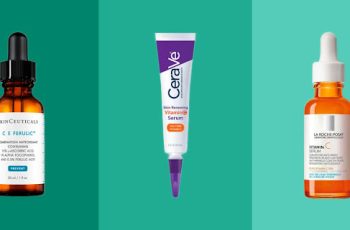
Can Niacinamide and Azelaic Acid be used together?
Skin care can be daunting and confusing at first, but once you get the hang of it, not only will you feel like a mad scientist with all the lotions and potions you use, but you’ll also see results in your overall skin appearance. So today’s goal is to clear up some information about these two powerful ingredients and find out if you can use both Niacinamide and Azelaic Acid together in your daily skin care routine.
What is Niacinamide?
Niacinamide is a popular ingredient because it has multiple benefits for every skin type and is able to address most skin concerns. Niacinamide has powerful anti-inflammatory properties and is a great ingredient for treating issues like breakouts and rosacea because it helps lock in moisture and minimizes the appearance of pores. By moisturizing the skin, it helps restore the health of the protective barrier on the surface of the skin that is often severely damaged. This damage is often caused by free radicals like pollution and UV rays, which can lead to a number of issues with the appearance of the skin and keep the skin healthy.
Key Benefits of Niacinamide for Skin Care: Locks in moisture in the skin and retains moisture.
Repairs damage to the protective barrier caused by free radicals.
Helps calm and soothe inflammation and redness.
Minimizes the appearance of fine lines and wrinkles that can make skin appear older.
Reduces the appearance of pores and keeps skin smooth.
Stimulates the skin’s immunity so it can protect itself.
You have to admit that this is an impressive ingredient, and you’ll be happy to know that it can be used alongside many other ingredients and give your skin the ultimate benefit to achieve your skin goals. But before you rush out to stock up on all your favorite products, you should know that there is one ingredient that isn’t always completely clear about how well it works with niacinamide: vitamin C. Many outdated reports advise against using vitamin C and niacinamide together, as each ingredient isn’t meant to be used together. The ingredients have similar effects on the skin. You’ll find that this is no longer an issue, as many people benefit from using these two powerful ingredients together. What is Azelaic Acid? Azelaic acid is another powerful ingredient that has a range of different benefits for the skin. It occurs naturally in the body and can be obtained from wheat, cereals, or it can be obtained synthetically. It contains a ton of impressive properties, such as antioxidants, anti-inflammatory agents, and gently exfoliates the skin. Azelaic acid varies in strength, with some formulas going up to 20%, but these are usually used in treatments in professional settings, such as peels. As with all acids, your skin becomes more sensitive to light, which means you need to wear a sunscreen of SPF 30 or higher every day to protect your skin from UV damage.
Key skincare benefits of azelaic acid: Gently exfoliates by removing dead skin cells and penetrating deep into the pores.
Has antimicrobial properties that reduce any P. acnes bacteria present on the skin, fighting active spots and blemishes.
Reduces skin pigmentation and dark spots, helping to even out skin tone.
May help treat rosacea flare-ups on the skin.
You might think that some of the benefits of azelaic acid are similar to those of niacinamide. I’ll tell you more about how to use these ingredients together, but if you want to learn more
If you want to learn more about niacinamide and azelaic acid, you can check out the dedicated blog post on our website.
How to use azelaic acid and niacinamide?
These two ingredients are often used in skincare products like serums, face oils, and creams. It’s best to consider the texture and consistency of these products when starting your routine.
What I mean is this: for example, if you have a serum rich in azelaic acid and a cream rich in niacinamide, then ideally you should apply the serum first. This allows the product to be fully absorbed into the skin without having to fight the barrier created by the cream when first applied. Now let me share with you some important tips for using niacinamide and azelaic acid together.
Important Tips for Using Azelaic Acid and Niacinamide Together Alternate between serums rich in each ingredient in your daily routine. The serum works deeper into the skin and provides a very effective boost to the skin, and the ingredients contained in the product work over time, resulting in faster and more noticeable results.
You can also mix it up a bit and apply niacinamide in the morning and azelaic acid in the evening. So you can be sure that each ingredient will work its gorgeous tricks and bring noticeable results to the skin.
You can use both ingredients twice a day. This means that if you have tested them on your skin and did not notice any signs of irritation or sensitivity, then you are good to go. By using both every day, your skin has a chance to see results faster. Don’t forget to apply SPF sunscreen every day. As already mentioned, azelaic acid makes the skin more sensitive to the sun. Therefore, it is very important to protect them from UV rays. This means that niacinamide can also repair any damage that has already occurred, and you don’t have to focus on keeping your skin barrier healthy and functional. You should discontinue use of both ingredients if your skin shows signs of irritation, redness, and sensitivity. Your skin may be more sensitive to azelaic acid than niacinamide, but it’s always a good idea to start from the beginning and understand the root causes of unwanted flare-ups. Hopefully, we’ve cleared up a few things today and made it easier for you to figure out how to incorporate these ingredients into your daily routine. As always, we strongly recommend consulting your doctor or dermatologist before using any new skincare products on your skin, especially if you have dry, sensitive skin. We’d love to hear your thoughts or even just have a chance to say hello, so follow us on our Instagram.


